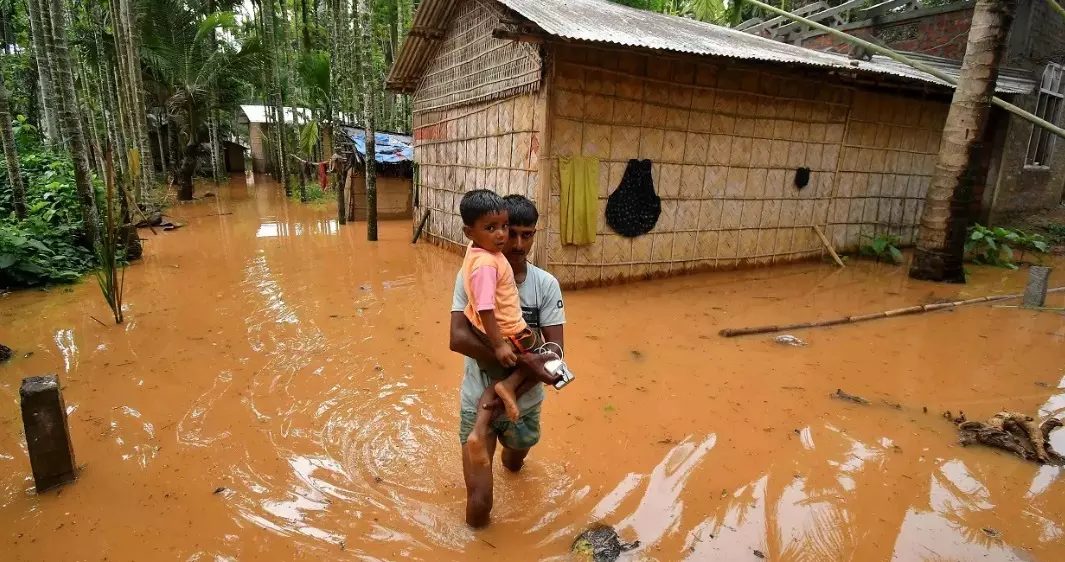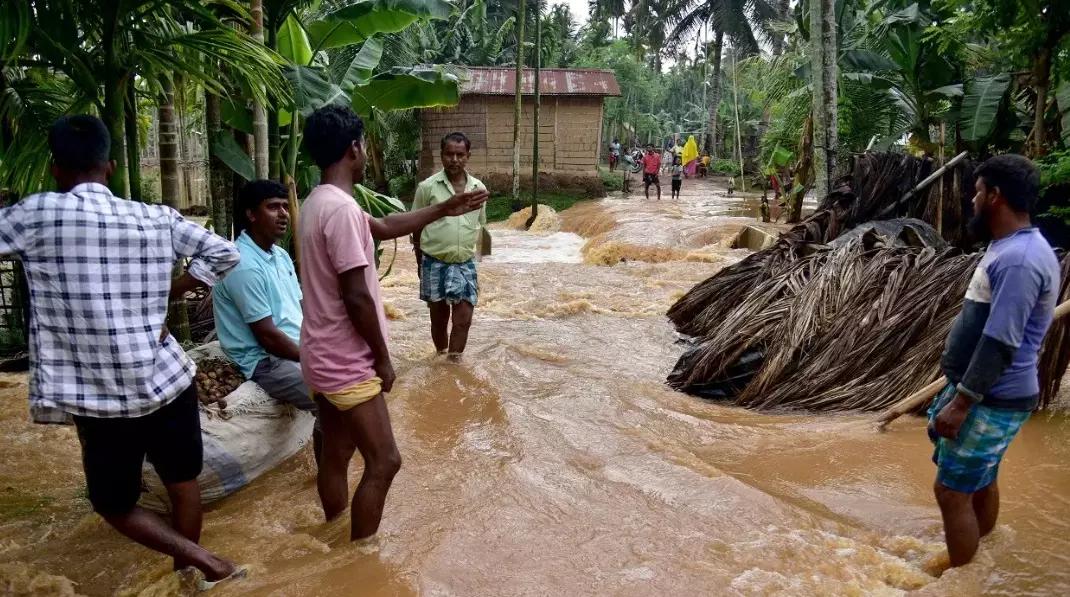
- Home
- India
- World
- Premium
- THE FEDERAL SPECIAL
- Analysis
- States
- Perspective
- Videos
- Sports
- Education
- Entertainment
- Elections
- Features
- Health
- Business
- Series
- In memoriam: Sheikh Mujibur Rahman
- Bishnoi's Men
- NEET TANGLE
- Economy Series
- Earth Day
- Kashmir’s Frozen Turbulence
- India@75
- The legend of Ramjanmabhoomi
- Liberalisation@30
- How to tame a dragon
- Celebrating biodiversity
- Farm Matters
- 50 days of solitude
- Bringing Migrants Home
- Budget 2020
- Jharkhand Votes
- The Federal Investigates
- The Federal Impact
- Vanishing Sand
- Gandhi @ 150
- Andhra Today
- Field report
- Operation Gulmarg
- Pandemic @1 Mn in India
- The Federal Year-End
- The Zero Year
- Science
- Brand studio
- Newsletter
- Elections 2024
- Events
Remal in Assam: A wake-up call for an eco-sensitive region?

The morning of May 28 was rather unusual in many places of Assam, a day after cyclone Remal made its landfall in Bangladesh and West Bengal. Only a day or two earlier, owing to an unprecedented heat wave resulting in temperatures soaring to over 40 degree Celsius, schools were rescheduled — opening as early as 7.30 am and closing by 1 pm.However, on the morning of May 28, schoolchildren...
The morning of May 28 was rather unusual in many places of Assam, a day after cyclone Remal made its landfall in Bangladesh and West Bengal. Only a day or two earlier, owing to an unprecedented heat wave resulting in temperatures soaring to over 40 degree Celsius, schools were rescheduled — opening as early as 7.30 am and closing by 1 pm.
However, on the morning of May 28, schoolchildren found the heat swept away by gusty winds and torrents of rain.
Since the midnight of May 27, several places in Assam, including the capital Guwahati, were rocked by high-velocity winds. ‘Dhumuha’ (storm in Assamese) is so deeply intertwined with Assam’s climatic conditions and culture that it finds mention in folk literature too. Yearly widespread destruction during April-May caused by ‘bordoisila’ (seasonal storm in Assamese) is customary in the state. But this May the story was different.
Why Remal was different
While bordoisila lasts only for an hour at the max, followed by rains, the gusty winds which started from around midnight on May 27 continued with the same intensity for nearly eight hours. The high-velocity winds uprooted many trees, brought down electric poles resulting in long power outages. Internet services stopped, houses were damaged injuring several people across the state, water supply was adversely impacted, and schools were declared closed in several districts, throwing normal life out of gear.
The trail of destruction left three dead. No district was probably spared from the wrath of the strong winds. This also makes the event different from the seasonal bordoisila, which is usually confined to certain areas. Assam and the entire Northeast have been facing cyclones originating in the Bay of Bengal year after year, but what the region saw this time was an extreme.
The event caused extreme hardship for the people.
“For over 24 hours, power was not available and critical patients had to be shifted to the Jorhat Civil Hospital from Kamala Miri Civil Hospital of Bokakhat amid torrential rains. The hospital’s generator was damaged in the aftermath of Remal,” said Pranab Doley, a youth leader and political activist from Bokakhat, the adjoining town of Kaziranga National Park.
“Power cuts enveloped the entire Bokakhat area for many hours. Even houses were destroyed by the storm in several instances. Bokakhat witnessed a serious devastation.” Doley told The Federal.
Stunned with the weather extremes, people in Assam are still grappling with some questions — was the cyclone strong enough to hit Assam or was the remnant of the cyclone stronger, helping it to travel thus to cause devastation? What role did climate change play in the event and how far did local meteorological factors amplify the cyclonic activities?
“Our region has historically experienced elevated rainfall during monsoon season. But the unprecedented intensity of this cyclone, with its devastating high-velocity winds and torrential rainfall far inland from the Bay of Bengal, has shocked and alarmed residents. Usually, cyclones originating in the Bay of Bengal bring heavy rainfall to the region, but the strong winds and intense downpour experienced during Remal were unusual,” said Sarat Phukan, a professor of geology at Gauhati University.
Commenting on the cyclone, some experts said that what struck Assam was just a remnant of Remal.
“The cyclone did not come to the northeast but the remnants created widespread devastation. Upon entering Assam, it was still as strong as a depression. This strength encountered orographic features and the heavy moisture content in this region helped it sustain for a longer time with high energy and become widespread,” Bhupen Goswami, noted meteorologist and former director of Indian Institute of Tropical Meteorology, Pune, said.
Orography refers to the study of mountain, hills and the elevated terrains of any part of a region. Assam and the northeast are topographically characterized by several hills and mountain ranges.

Thousands were displaced in the aftermath of Cyclone Remal. Photo: PTI
“The cyclone was also peculiar in terms of the direction it traversed post landfall — it moved north-east and not the usual north-west. The landfall area was also not far from northeast,” Goswami said, adding, “The cyclone system’s dynamics would have pushed it westward, but the largescale wind patterns or other factors like El Nino pushed it to move north. From there it directly came to the eastern part of the Sundarbans. The system moved further east and hit the hills of Meghalaya.”
“The clouds were dense and circulating counter clockwise when nearing north eastern region, particularly the Meghalaya-Assam border. The remnants of the cyclone brought moisture from Bay of Bengal and after reaching the northeast, the high-level moisture in the region (in the form of humidity) kept fuelling the system for a longer time and we experienced gusty winds, thunderstorms and the devastation,” he said.
Massive energy
A cyclone is created over a warm sea surface where moisture is abundant; in fact, it is moisture that fuels a cyclone. The warmer the sea, more the moisture and more energetic the cyclone. As a cyclone moves from the sea surface towards land, it contains the high energy. But once it meets the land, it weakens as there is not as much moisture as on the sea surface. It’s like a car running out of fuel and unable to move further.
But Remal’s landfall area, Goswami elaborated, was not far from the Northeast. Given its high energy at landfall (a super cyclone) and with its direction, it reached the northeast with high energy. This was coupled with supply of abundant moisture and orography in the region which made it worse.
While the cyclone’s impact on Assam was unprecedented, experts believe live could have been saved.
Low on preparedness
Goswami said the loss of lives and other calamities is a manifestation of gaps in administrative preparedness. “Our local administration is not geared up to disaster management issues of extreme events. This is partly because we are apathetic to the fact that the extreme events are on the rise. Take for example pollution in Guwahati, which was at an extreme level. When such issues are discussed, the administration is always in denial mode,” he said.
The Assam State Disaster Management Authority (ASDMA), however, claims it was fully prepared.
An ASDMA official said the agency sent out well-spelled out notices to the districts and held a meeting of state District Disaster Management Authorities on May 25. It said due preparations were made.
While ASDMA may have held meetings and delegated ‘what-to-do’ advisories to the districts, the question is whether the message percolated. According to Pranab Doley, the ‘early warning’ system failed to ensure the message reached everyone.
“We saw policemen more active than ASDMA officials. Moreover, the electricity department appeared very inefficient. There are villages in and around Bokakhat which remained in the dark for over a week. We approached the SDO (sub divisional officer) multiple times. Each time we were told that he is ‘in the field’, said Doley.
In their Science paper published in 2006, Goswami and his colleagues warned that extreme rainfall events in India are increasing by 10 per cent with each passing decade. In 50 years (1950-2000), the rate has increased significantly to 50 per cent, thanks to global warming.
Wake-up call?
With Assam and the entire Northeast being one of the most eco-sensitive zones of the country where rainfall is in abundance and humidity remains high, global warming can prove disastrous if something like Remal comes closer. Moreover, tropical cyclones are increasing in frequency and intensity as a direct consequence of climate change.
According to Prof. Sarat Phukan, cyclone Remal served as a dire wake-up call for Assam, a region already grappling with recurring earthquakes, annual monsoon flooding and landslides. The addition of more frequent and intense cyclones to this litany of climate change-induced disasters paints a bleak picture for the future.
The region’s mean temperature has increased by 1.7 or 2 degrees over a century, which has translated into 14 per cent more moisture content (humidity). He said that 20 centimetres of rain per day was common but extreme rainfalls like 40 centimetres a day have increased in frequency. “Earlier, this would have happened once or twice during monsoon. Now, such extreme events have gone up to four or sometimes five times.” More moisture means providing more fuel to a cyclone.
“The cyclone’s exceptional force and the widespread damage it inflicted underscore how climate change is supercharging these storms. Warmer oceans, a direct result of global warming, fuel cyclones, making them more powerful and destructive. This is consistent with scientific consensus and we can expect these events to become more frequent and intense in the coming years. Moreover, rapid and often unplanned development activities and urbanization have magnified the cyclone’s impact,” Prof Phukan added.
Humid heat stress
A temperature of 35 degrees, coupled with 70 per cent humidity can make one feel like the temperature is 45 degrees. This year, Assam recorded the highest ever temperature in six decades, with above 40 degrees in many places. In such a situation when the humidity is also high, the real feeling would be that of nearly 50 degrees.

People in Assam stayed without power for days, amid damaged houses and roads. Photo: PTI
Goswami and his team at Cotton University is researching on humid heat stress in Assam and attempting to prepare a ‘Humidex’ — combining humidity, temperature and heat stress index. “If the humidex is 45, then it becomes dangerous. Earlier, we used to have 20 such extreme days during summer, which has gone up to 80 days now,” he said.
Probably, a more sustainable economic policy and hence a way of climate adaptation is the only way out. “Deforestation, encroachment on wetlands and the alteration of natural drainage patterns have undermined the region’s natural defences against storm surges and flooding. The relentless pursuit of economic growth cannot continue to disregard environmental resilience,” Phukan said.
